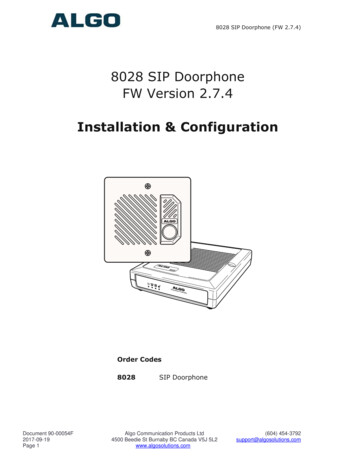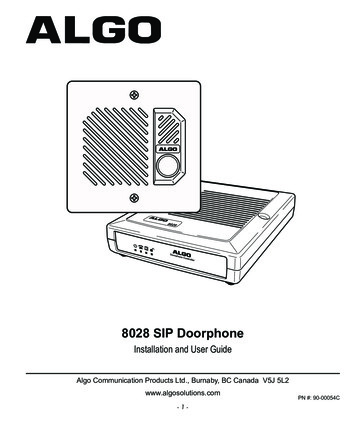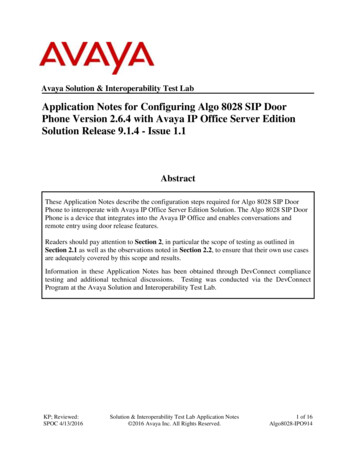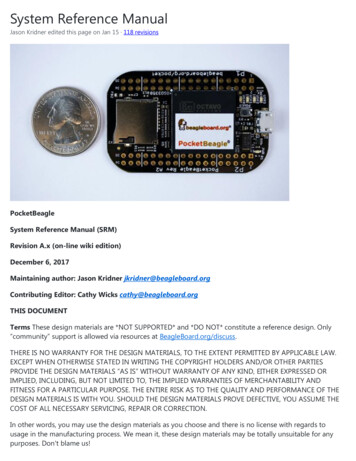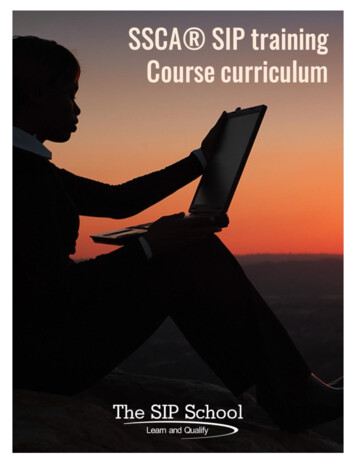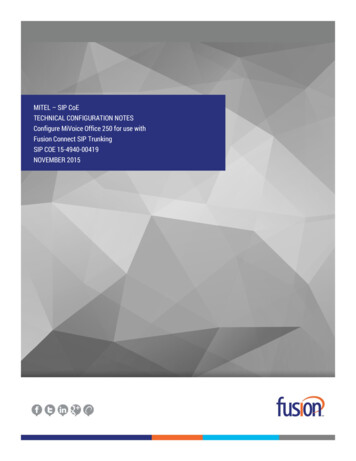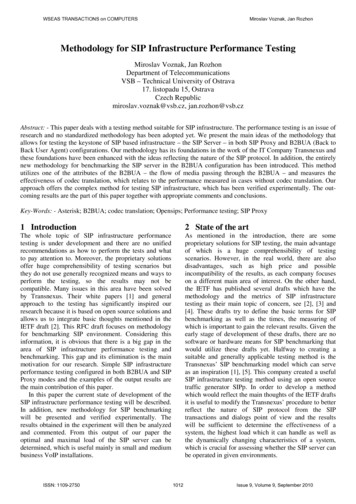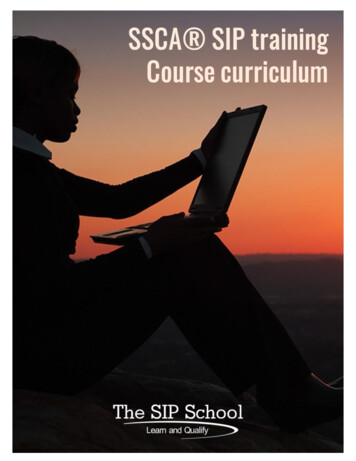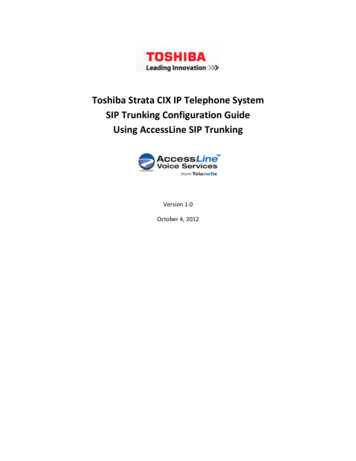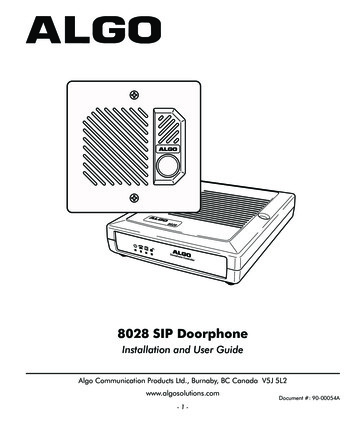
Transcription
8028 SIP DoorphoneInstallation and User GuideAlgo Communication Products Ltd., Burnaby, BC Canada V5J 5L2www.algosolutions.com-1-Document #: 90-00054A
Important Safety NoticeThe 8028 SIP Doorphone is designed and tested to comply with EN 60950-1:2006 safetyrequirements.When the Doorphone Controller is connected to wiring that exits the building, there ispotential risk of lightning induced electrical surges or high voltages from fault conditions.To reduce risk, outdoor wiring should be protected by Earth grounded conduit wheneverpossible.If outdoor wiring will be connected to the Doorphone Controller then the power supply providedwith the Doorphone Controller must first be connected to a properly Earthed mains supply.Under no circumstances can the Doorphone Controller be disconnected from Earth ground whileconnected to outdoor wiring.SupportAlgo is pleased to offer telephone or email support relating to installation issues, applicationsassistance, or general product inquiries.Algo Communication Products Ltd.4500 Beedie StreetBurnaby, British ColumbiaCanada, V5J 5L2support@algosolutions.com604.454.3792 or 877.884.2546 (Toll free North America)sales@algosolutions.com604.454.3790Algo products are warranted against defect in workmanship for a period of 12 months afterinstallation not to exceed 18 months from date of manufacture. For warranty or non-warrantyrepair support please contact your distributor or reseller. If necessary, contact Algo using the supportcontacts listed above.FCC ComplianceThis equipment has been tested and found to comply with the limits for a Class B digital device, pursuant to part 15of the FCC Rules. These limits are designed to provide reasonable protection against interference in a residentialinstallation. This equipment generates, uses, and can radiate radio frequency energy and, if not installed andused in accordance with the instructions, may cause harmful interference to radio communications. However, thereis no guarantee that interference will not occur in a particular installation. If this equipment does cause harmfulinterference to radio or television reception, which can be determined by turning the equipment off and on, the useris encouraged to try to correct the interference by one or more of the following measures: 1) Reorient or relocatethe receiving antenna, 2) Increase the separation between the equipment and receiver, 3) Connect the equipmentinto an outlet on a circuit different from that to which the receiver is connected, or 4) Consult the dealer or anexperienced radio/TV technician for help.-2-
Table of ContentsSupport . . . . . . . . . . . . . . . . . . . . . . . . . . . . . . . . . . . . . . . . . . . . . . . . . . 2FCC Compliance . . . . . . . . . . . . . . . . . . . . . . . . . . . . . . . . . . . . . . . . . . . 2Important Safety Notice . . . . . . . . . . . . . . . . . . . . . . . . . . . . . . . . . . . . . . 2Introduction . . . . . . . . . . . . . . . . . . . . . . . . . . . . . . . . . . . . . . . 4Features . . . . . . . . . . . . . . . . . . . . . . . . . . . . . . . . . . . . . . . . . . . . . . . . . 4Quick Install & Test . . . . . . . . . . . . . . . . . . . . . . . . . . . . . . . . . 5Applications . . . . . . . . . . . . . . . . . . . . . . . . . . . . . . . . . . . . . . . 6Typical Applications for Auxiliary Inputs and Outputs . . . . . . . . . . . . . . . . 6Door or Gate Control Basics. . . . . . . . . . . . . . . . . . . . . . . . . . . 8Door Release . . . . . . . . . . . . . . . . . . . . . . . . . . . . . . . . . . . . . . . . . . . . . 8Setup and Installation . . . . . . . . . . . . . . . . . . . . . . . . . . . . . . 10Programming and Configuration. . . . . . . . . . . . . . . . . . . . . . 11Web Interface Control Panel . . . . . . . . . . . . . . . . . . . . . . . . . . . . . . . . . 11NAT . . . . . . . . . . . . . . . . . . . . . . . . . . . . . . . . . . . . . . . . . . . . . 19STUN Server . . . . . . . . . . . . . . . . . . . . . . . . . . . . . . . . . . . . . . . . . . . . . 19Asterisk and other SIP Servers . . . . . . . . . . . . . . . . . . . . . . . . . . . . . . . . 19Auto-Provisioning (via TFTP) . . . . . . . . . . . . . . . . . . . . . . . . . 20MD5 Checksum . . . . . . . . . . . . . . . . . . . . . . . . . . . . . . . . . . . . . . . . . . 20Generating a generic configuration file . . . . . . . . . . . . . . . . . . . . . . . . . 20Generating a specific configuration file . . . . . . . . . . . . . . . . . . . . . . . . . 21Connections and Lights . . . . . . . . . . . . . . . . . . . . . . . . . . . . . 22Auxiliary Dry Contact Outputs . . . . . . . . . . . . . . . . . . . . . . . . . . . . . . . .Auxiliary Dry Contact Inputs . . . . . . . . . . . . . . . . . . . . . . . . . . . . . . . . .LED Details . . . . . . . . . . . . . . . . . . . . . . . . . . . . . . . . . . . . . . . . . . . . . .Connection Details . . . . . . . . . . . . . . . . . . . . . . . . . . . . . . . . . . . . . . . .22222324Specifications . . . . . . . . . . . . . . . . . . . . . . . . . . . . . . . . . . . . . 25-3-
IntroductionIdeal for secure business entrances, emergency intercom, and residential gates,Algo’s 8028 SIP Doorphone provideshands-free intercom capability,entrance security with door unlockcontrol, rugged weatherproof design,and superior audio performance.Fully compatible with SIP industrystandards, the 8028 SIP Doorphonewill work with most hosted orenterprise SIP-based servers supportingthird-party SIP endpoints.The 8028 Doorphone includes aControl Unit, Door Station, and PowerSupply. The Control Unit and DoorStation can be connected with a single twisted pair wire up to 1,000 feet (300m) with the Door Station located outdoors and the Control Unit in a dry indoorlocation.Features Suitable for commercial or residential applications Door Station connected by a single twisted wire pair Full duplex capable hands-free voice communication at the Door Station Door control relay contacts and available 24 Vdc 0.3 A strike power Auxiliary dry contact inputs and outputs from Doorphone Controller andDoor Station Programmable via Web Interface International 110/220 V, 50/60 Hz switching power supply Regulatory: CSA/UL, FCC Class B, CE, EN60950-1 2006 CB Scheme-4-
Quick Install & TestThe 8028 SIP Doorphone requires minimal configuration for a typicalinstallation. Programming is only required to enter the SIP account details, andfor more advanced applications.1. Connect the power supply to thePower Jack of the DoorphoneController and plug into anavailable AC outlet.SIP Server2. Flush or surface-mount the DigitalDoor Station at desired location andconnect a twisted telephone wirepair between the “CTRL” terminalsof the Door Station and the centerpair (red and green) of the suppliedTelephone Wiring Jack. Polarity isnot important.3. Using the short six conductor modularcable, connect the Telephone WiringJack to the Door Station Jack of theDoorphone Controller.4. Using an Ethernet cable, connect the Ethernet Jack of the DoorphoneController to your LAN.5. Press the Call Button on the Door Station. A recorded voice will speak theIP Address of the device. Enter this address in a PC web browser in orderto open the Web Interface. Note: The spoken IP address feature will beautomatically disabled after a SIP Server is configured in Step 6 (below).6. Use the Web Interface to enter the SIP Proxy Server address as well asthe user account and password that the 8028 SIP Doorphone will use toregister. Also enter the target extension that the Doorphone will call.7. Press the Call Button on the Door Station, then answer to communicate withthe Door Station. Press the digit 6 on the phone keypad to activate the doorcontrol relay for three seconds (if applicable).-5-
ApplicationsTypical Applications for Auxiliary Inputs and OutputsThe 8028 architecture and digital link between the Door Station and Controllerprovides flexible options using the auxiliary inputs and outputs. These are sometypical applications:Cancel Ring When Door OpenedIn a residential or warehouse installation it is not uncommon for the door tobe answered in person before the phone is answered. Either Door Station orControl Unit inputs can be configured to cancel ring if the door is openedbefore a call is answered. This requires a normally closed or normally opencontact to detect door open.Trigger Door Bell from Door StationWhen the Door Station call button is pressed, either (or both) the Door Stationor Control Unit dry contact output can be configured to activate a door bell orauxiliary alerting system in addition to phone ring.Trigger Door Station from External Button/EventEither the Control Unit or Door Station can accept a dry contact closure toactivate the Doorphone as if the call button had been pressed. This could be anexternal doorbell button, PIR detector, or some other system.Cancel Door Open Relay once Door OpenedThe door opening control can be set for activation (using the Open Code’) upto 30 seconds (set by the Relay Time’ setting) to allow sufficient time for entry.For security, the 8028 Doorphone can be configured to cancel Door Openingonce the door is opened to prevent “tailgating” by unauthorized personnel.Unlock Door Indefinitely until CanceledThe door opening control can be set to unlock indefinitely (using the LatchOpen Code’) until canceled (using the Release Code’) that locks it again. Thisallows an entrance to be used repeatedly for a period of time without requiringmultiple activations of the door control relay.-6-
Anti-Door TamperA feature of the 8028 Doorphone is to ring the telephone(s) with a warning alertin the event a door is ajar due to tampering (such as a door blocked open afterbeing legitimately released for a visitor).In-Use and RingEither the Control Unit or Door Station can be configured to provide a drycontact output during ring or in-use for channel selection (typically) of thirdparty video monitoring systems.-7-
Door or Gate Control BasicsControl contacts are provided from the Doorphone Controller and are typicallyused for door strike activation or gate control. For security, the door controlrelay is located in the Controller to avoid entry by tampering. The Door Stationdry contact output (OUT) may be configured for ‘low security’ gate controlrequiring a low current dry contact.Door ReleaseDoor release typically involves energizing or de-energizing a door strike whichpivots to allow a locked door to open without retraction of the latch bolt. Thereare two different types of door strikes: “Fail Locked” (or “Fail Secure”) “Fail Unlocked” (or “Fail Safe”)Fail Locked / Fail Secure Electric StrikeThese require power to release andremain locked during power failure. Thedoor may still normally be opened fromthe outside with a key, or from insidewithout a key. The door control relay isused to apply power to release the door.24V 0.3ADoorStrike“Fail Locked”24 Vdc 0.2 A TypicalFail Unlocked / Fail Safe Electric StrikeThese (as well as magnetic locks), requirepower to lock and become unlockedduring power failure. The door controlrelay is used to maintain power to thedoor lock (NC and C contacts) which isinterrupted to release the door. Magneticlocks may require override systems toallow safety exit in the event of fire.-8-24V 0.3A“Fail Unlocked”24 Vdc 0.2 A Typical
Power SupplyThe Doorphone Controller provides an auxiliary 24 V 0.3 A power supplywhich is suitable for common types of door strikes. If more current or a differentvoltage is required, then the customer must provide a matching power supplyfor the electric strike or magnetic lock. Maximum switching capability of thedoor control contacts is 1 A 30 V.The Door Control relay may also be configured for alternate functionalityincluding In-Use, Ring, and Call Button Press.For more information on applications for the 8028 SIP Doorphone,please visit www.algosolutions.com/8028. The 8028 Doorphonefirmware may be modified through the web interface and Algo routinelyaccepts requests for custom firmware for unique applications.-9-
Setup and Installation8028 SIP Doorphone Controller24V 0.3A24VDC 0.6ARESETDoor Control Relay see Door ControlSectionReset ButtonPower Input 24V 0.6ADoor Station JackEthernet Jack. Connect toLAN with access to SIPProxy Server6-Wire ModularCable (Supplied)Telephone WiringJack (supplied)BLACKWHITEBLUEWHController DryContact OutputBLBKYRDGLYELLOWZREDController DryContact InputGREENTwisted pairtypical 24AWGMax 3000 feet (900m)Station DryContact InputDoor StationStation DryContact OutputCTRLINOUT- 10 -
Programming and ConfigurationConnection to Network and Obtaining IP AddressAfter connecting the 8028 to a network port, watch for the PWR light to startwinking (on and blinking off) during initialization. The 8028 will then attemptto obtain an IP address from the DHCP server. If unsuccessful, the 8028 willdefault to the fixed IP address 192.168.1.111.To find the IP address of the 8028, press the Call Button on the Door Station.The 8028 will speak its IP address if it has not yet been configured with a SIPServer address. Alternatively, search the network using the 8028 Locator Toolavailable for download from www.algosolutions.com/8028locator.Web Interface Control PanelThe 8028 is programmed using a web interface tool accessed by entering the8028 IP address into a browser. Using this interface, you can configure the8028 network settings and select the desired options. These settings survivepower cycling and may be programmed in advance prior to site installation.- 11 -
Configuration OptionsSIPSIP Domain/ProxySIP Server Name or IP addressOutbound Proxy(optional)Outbound proxy is a proxy (server) that stands between a privatenetwork and the Internet.STUN Server(optional)Allow communication between SIP server and 8028 if NAT ispresent (see “NAT” on page 19).Registrar(optional)A registrar is a server that accepts REGISTER requests from SIPdevices. Configure Registrar if the SIP Proxy does not acceptREGISTER requests.Register Period(seconds)Maximum requested period of time where the 8028 will re-registerwith the SIP server. Default setting is 3600 seconds (1 hour). Onlychange if instructed otherwise.Keep-aliveMethodMaintain connection between the 8028 and the SIP Server if the8028 is behind NAT.Keep-alive Period(seconds)Period of time where the 8028 will send some information to theSIP Server to keep the connection alive.ExtensionThe phone number that the 8028 registers with the SIP Server. Itwill auto-answer any inbound calls.Auth IDAuthentication ID; Used to register the device on the SIP Server.PasswordSIP password used to register the device on the SIP Server.Dialing ExtensionPhone number to be dialed when the Call button on the doorstation is pressed.- 12 -
FeaturesAudio SettingsSpeaker VolumeSpeaker audio level in 3 dB steps (Default: 8)Microphone VolumeMicrophone audio level in 3 dB steps (Default: 7)DSP Noise Reduction Full Duplex with Noise Reduction Full Duplex without Noise Reduction (Default)Ringback ToneAllows audible ringback tone to be played on Door Stationspeaker until call is answered Enabled (Default) DisabledInbound Call SettingsAnswer Inbound CallAuto-answer or ignore inbound calls Enabled (Default) DisabledAnswer ToneAn optional beep tone can be played at the Door Stationwhen it answers an inbound call Enabled (Default) Disabled- 13 -
Door Relay SettingsMomentary Open CodeDurationCancel if DoorOpened1-4 digit DTMF code that can be used to unlock the door fora brief period of time (as set by the Relay Time field). Leavethis field blank to disable this feature. (Default: 6)The duration for which to unlock the door when theMomentary Open Code is entered.Cancels the door unlock (i.e. locks the door again) if thedoor has been opened to ensure it cannot be opened a 2ndtime. Only available if the controller input or door station isconfigured for Door Sensor mode.Latch Open Code1-4 digit DTMF code that can be used to unlock the doorindefinitely. Leave this field blank to disable this feature.Latch Closed Code1-4 digit DTMF code that will lock the door again when it islatched open. Leave this field blank to disable this feature.Ring SettingsOutbound Ring LimitCancel if DoorOpened No ring Limit to 1-9 rings (Default: 5 Rings) No limit No (Default) Yes- 14 -
Auxiliary I/O SettingsController Output In-Use (Default)RingCall Button PressDoor ControlDoor SensorDoor Alarm Follow Controller Input Follow Station Input DisabledDoor Station Output In-UseRingCall Button Press (Default)Door ControlDoor Sensor Door AlarmFollow Controller InputFollow Station InputDisabledDoor Relay In-UseRingCall Button PressDoor Control (Default)Door Sensor Door AlarmFollow Controller InputFollow Station InputDisabledController Input Door Sensor, Normally Open InputDoor Sensor, Normally Closed Input (Default)Manual Door Release InputDoor Control Lockout InputCall Button, Normally Open InputCall Button, Normally Closed InputDisabledDoor Station Input Door Sensor, Normally Open InputDoor Sensor, Normally Closed InputCall Button, Normally Open Input (Default)Call Button, Normally Closed InputDisabled- 15 -
Security SettingsMax Door OpenIf the Controller or Door Station input is connected to aphysical door sensor and also configured in Door Sensormode (See “Auxiliary I/O Settings” on page 15), then a DoorAlarm condition can be triggered if the door remains open forlonger than a threshold of: 30 sec 60 min 2 min 90 min 15 min 120 min 30 min NoneDoor Open AlarmWhen a Door Alarm condition is detected based on the MaxDoor Open time above being exceeded, then the 8028 cangenerate a notification call.Call every: 2 min (Default) 10 min 30 minDoor StationDisconnected 1 hour NoneIf a wiring fault occurs that breaks communication with theDoor Station, then the 8028 can generate a notification call.Call every: 2 min 10 min 30 min 1 hour None (Default)- 16 -
NetworkDHCPDynamic Host Configuration Protocol (DHCP) is an IP standarddesigned to make administration of IP addresses simpler.Normally set to On, DHCP will automatically configure IPaddresses for each 8028 on the network. Alternatively, if your ITAdministrator has assigned one or more static IP addresses, setthe DHCP setting to Off.VLAN SupportVLAN Tagging (or IEEE 802.1Q) allows sharing of a physicalnetwork link by multiple independent networks.VLAN IDA 12-bit field specifying the VLAN to which the frame belongs. Avalue of 0 means that the frame does not belong to any VLAN.The hexadecimal values of 0x000 and 0xFFF are reserved. Allother values may be used as VLAN identifiers, allowing up to4094 VLANs.VLAN PriorityPriority Code Point (PCP): a 3-bit field which refers to the IEEE802.1p priority. Values are from 0 (best effort) to 7 (highest); 1represents the lowest priority.DHCP Timeout(seconds)Length of time following a request from an 8028 to the DHCPserver that the 8028 will wait before assuming the server is notavailable. After such time, the 8028 will use its default address(192.168.1.111). Default timeout is 60 seconds.NTP ServerNetwork Time Protocol server IP address. Allows device toautomatically set its clock by connecting to an external server.- 17 -
AdminDevice NameName to identify the device on the network (similar to “ComputerName” field in Windows).PasswordPassword to log into the 8028 web interface.You should change the default password in order to secure thedevice on the network. If you have forgotten your password, a softreset will restore the default setting (including all of the device’sdefault settings). To do this, first disconnect power from the 8028Doorphone Controller. Then press and hold the Reset button onthe back of the device, and while doing this, reconnect the power.Continue to hold the Reset button until the LEDs on the front of thecontroller start to flash.ProvisioningSee “Auto-Provisioning (via TFTP)” on page 20.Log LevelAmount of information provided in the log files. This value shouldonly be changed if advised by Algo.Log SizeAmount of internal memory reserved for recording log file. Defaultis 100 kB.Log MethodSets storage location of log file data. Default setting is Local.Choose Network (or Both) to send log messages to any “Syslog”server, an option to prevent loss of data during a powerdown.Log Server IPIP address of Log Server if Log Method is set to Network or Both.Format: #.#.#.#- 18 -
NATNAT (Network Address Translation) is located between a private network andthe Internet. When properly configured, it allows an 8028 installed on a privatenetwork to have access to the outside world, such as would be required whenusing a hosted SIP provider (i.e. a SIP server that is remotely located).Algo provides NAT support for both STUN and Asterisk. To configure NAT forthe server that applies to your application, follow these steps:STUN Server1. Enter the STUN Server nameor IP address2. Set Keep-alive Method toNone3. Click Save SettingsAsterisk and other SIPServers1. Set Keep-alive Method toDouble CRLF2. Set Keep-alive Period to 303. Click Save SettingsThe NAT library sends the binding requests for each port every 30seconds to ensure NAT mapping is valid all the time.- 19 -
Auto-Provisioning (via TFTP)Auto-provisioning allows installers to pre-configure 8028 units prior toinstallation on a network. It is typically used for large deployments.If desired, 8028 configuration files can be automatically downloaded from aTFTP (Trivial File Transfer Protocol) server using DHCP Option 66. Option 66is a term used by some DHCP vendors to describe DHCP code 66. This optioncode (when set) supplies a TFTP boot server address to the DHCP client to bootfrom.DHCP must be enabled in order to use DHCP Option 66 forauto-provisioning.FTP and HTTP protocols are also supported, as well as a staticProvisioning Server address instead of DHCP Option 66.One of two files can be uploaded on the TFTP server: generic file algop8028.conf, or specific file algom[MAC].confMD5 ChecksumIn addition to the .conf file, an .md5 checksum file must also be uploaded to theTFTP server. This checksum file is used to verify that the .conf file is transferredcorrectly without error.A tool such as can be found at http://www.fourmilab.ch/md5 may be used togenerate this file.- 20 -
Generating a generic configuration file1. Connect an 8028 on the network2. Access the 8028 web interface3. Configure the 8028 with desired options4. Click on the Services tab and then on Backup Settings5. Save the file settings.txt6. Rename file settings.txt to algop8028.conf7. File algop8028.conf can now be uploaded on the TFTP serverIf using a generic configuration file, extensions and credentials have tobe entered manually once the 8028 has automatically downloaded theconfiguration file.Generating a specific configuration file1. Follow steps 1 to 5 as listed in the section “MD5 Checksum” on page 20.2. Rename file settings.txt to algom[MAC address].conf(e.g. algom0022EE020009.conf)3. File algom[MAC address].conf can now be uploaded on the TFTP server.The specific configuration file will only be downloaded by the 8028with the MAC address specified in the configuration file name. Sinceall the necessary settings can be included in this file, the 8028 will beready to work immediately after the configuration file is downloaded.The MAC address of each 8028 can be found on the back label of theunit.- 21 -
Connections and LightsAuxiliary Dry Contact OutputsBoth the Doorphone Controller and Door Station provide a dry contact outputfor connection to auxiliary devices. Maximum switching capacity is 30 V 50 mA.Default operations are as follows: Doorphone Controller Output In-Use (commonly used for camera control) Door Station Output Call Button Press (commonly used to activate asecondary door bell)Other options for Doorphone Controller output include Ring and Call ButtonPress. Other options for Door Station output include In-Use and Door Control.Auxiliary Dry Contact InputsBoth the Doorphone Controller and Door Station can detect a dry contactclosure from auxiliary devices. A non-capacitive and non-inductive low voltageand low current is used to detect contact closure.Default operations are as follows: Doorphone Controller input Door Sensor Normally Closed (used todetect door open) Door Station input Call Button Normally Open (used to detect externaldoorbell switch)Options for Doorphone Controller input include Door Sensor Normally Closed,Door Sensor Normally Open, Manual Door Release, Door Control Lockout, CallButton Normally Closed, and Call Button Normally Open.Options for Door Station input include Door Sensor Normally Closed, DoorSensor Normally Open, Call Button Normally Closed, and Call ButtonNormally Open.See “Configuration Options” on page 12 for more information on settingup auxiliary inputs and outputs.- 22 -
LED DetailsPower On steady: Power is OK, but Ethernet Link not established Blinks one second on, one second off: Ethernet Link statusOK, but IP Address not yet obtained Light on, blinks off briefly every two seconds: Link and IPAddress established successfullyTelephone Off - Not registered with SIP server Light on, blinks off briefly every two seconds: Successfullyregistered with SIP Server, ready for use Blinks one second on, one second off: error registering withSIP Server – check configuration On steady: offhook or ringing state is currently activeDoorStation On steady when door station is connected Flashing indicates communication errorsLock On when Door Relay is activated May flash to indicate when the door is opened (if the drycontact is triggered, and configured as a door detector)- 23 -
Connection DetailsDoor ControlRelay5 Position RemovableTerminal BlockAuxiliaryPowerDoor Station JackRJ12 Telephone JackEthernet JackRJ45 Telephone JackNONormally OpenCCommonNCNormally ClosedPWR -0.3 A (GND)PWR 0.3 A (24 V)Center Pair (Red &Green)Door StationMiddle Pair(Yellow & Black)Dry Contact InputMax 1 kΩOutside Pair(Blue & White)Dry Contact OutputMax 50 mA 30 V24V 0.3AConnect to LAN with access toSIP-compliant Proxy ServerReset ButtonTo return all settings to a factory default,press and hold the reset button at startup.Continue to hold the button until all LEDsstart to flash.Door StationCTRLConnect to Door Station Jackof Doorphone ControllerINDry Contact Input to DoorStation (e.g. Door Contact,Doorbell Switch); Max. 1 kΩOUTDry Contact Output fromDoor Station (e.g. GateControl); Max 50 mA 30 V6 Position Terminal Block- 24 -RESETCTRLINOUT
SpecificationsCompatibilityConfigurationSIPWeb Interface or TFTP Auto-ProvisioningNetwork AddressNAT (Network werIndicatorsNetwork ConnectionInstallationEnvironmentalDoor Control ConnectionDoor Control PowerDoor Control RelayDoor Station ConnectionDoor Station WiringAuxiliary InputConnectionAuxiliary Input ElectricalAuxiliary Input FunctionsDHCP or static IP addressSTUN Server or Keep-AliveAuxiliary OutputConnectionAuxiliary OutputElectricalAuxiliary OutputFunctionsFull Duplex CapableG.711Separate Controller and Door StationAC Mains Adapter 95-230 V 50/60 Hz IncludedPower, Door Station Status, In-Use, Door UnlockRJ45 JackShelf or wall mountedDry indoor location5 Position terminal stripAvailable 24 V, 300 mA Strike power /Relay C, NO, NC phone keypad activated; Maximum 30 V, 1 ARJ12 Jack Center Pair24 AWG Twisted Pair to 1000 Ft (300 m)RJ12 Jack Second PairDetects dry contact closure 24 V 4 mA sensing currentManual door release; Door control lockout; Door sensorNC (Default) or NO; Call button NC or NO; DisabledRJ12 Jack Outside PairNormally open switch 180 Ohms active; Maximum 30 V,50 mAIn-Use (Default); Ringing; Call button pressed; Doorunlock; Door open (requires door sensor); Door alarm(requires door sensor); Door sensor NC (Default) or NO;Follow Controller input; Follow Door Station input; Disabled- 25 -
Door StationPowerWiringSignallingCall y Input ElectricalAuxiliary Input FunctionsAuxiliary OutputElectricalAuxiliary OutputFunctionsProvided by Controller linkUp to 1,000 Ft (300 m) 24 AWG single twisted pair tocontrollerDigital link - bi-directional voice and dataBacklit tactile silicon rubber6 Position terminal strip - Controller, Aux In, Aux OutFlush or surface mounted using supplied plastic bezel; Fitstwo gang electrical boxNEMA 3R Rated for outdoor locations; Ambient temperature-30 to 60 C.Detects dry contact closure 5 V, 1 mA sensing currentDoor sensor NC or NO; Call button NC or NO (Default);DisabledNormally open switch 180 Ohms active; Maximum 30 V,50 mAIn-Use; Ringing; Call button pressed (Default); Door/gateunlock; Door open (requires door sensor); Door alarm(requires door sensor); Door sensor NC (Default) or NO;Follow Controller input; Follow Door Station input; DisabledSpecifications are subject to change without notice. Some features mayonly be available in specific firmware or hardware releases.- 26 -
Note: This page left intentionally blank.- 27 -
Algo Communication Products Ltd., Burnaby, BC Canada V5J 5L2www.algosolutions.com- 28 -
The 8028 SIP Doorphone is designed and tested to comply with EN 60950-1:2006 safety . Algo's 8028 SIP Doorphone provides hands-free intercom capability, entrance security with door unlock . Press the digit 6 on the phone keypad to activate the door control relay for three seconds (if applicable). - 6 -
